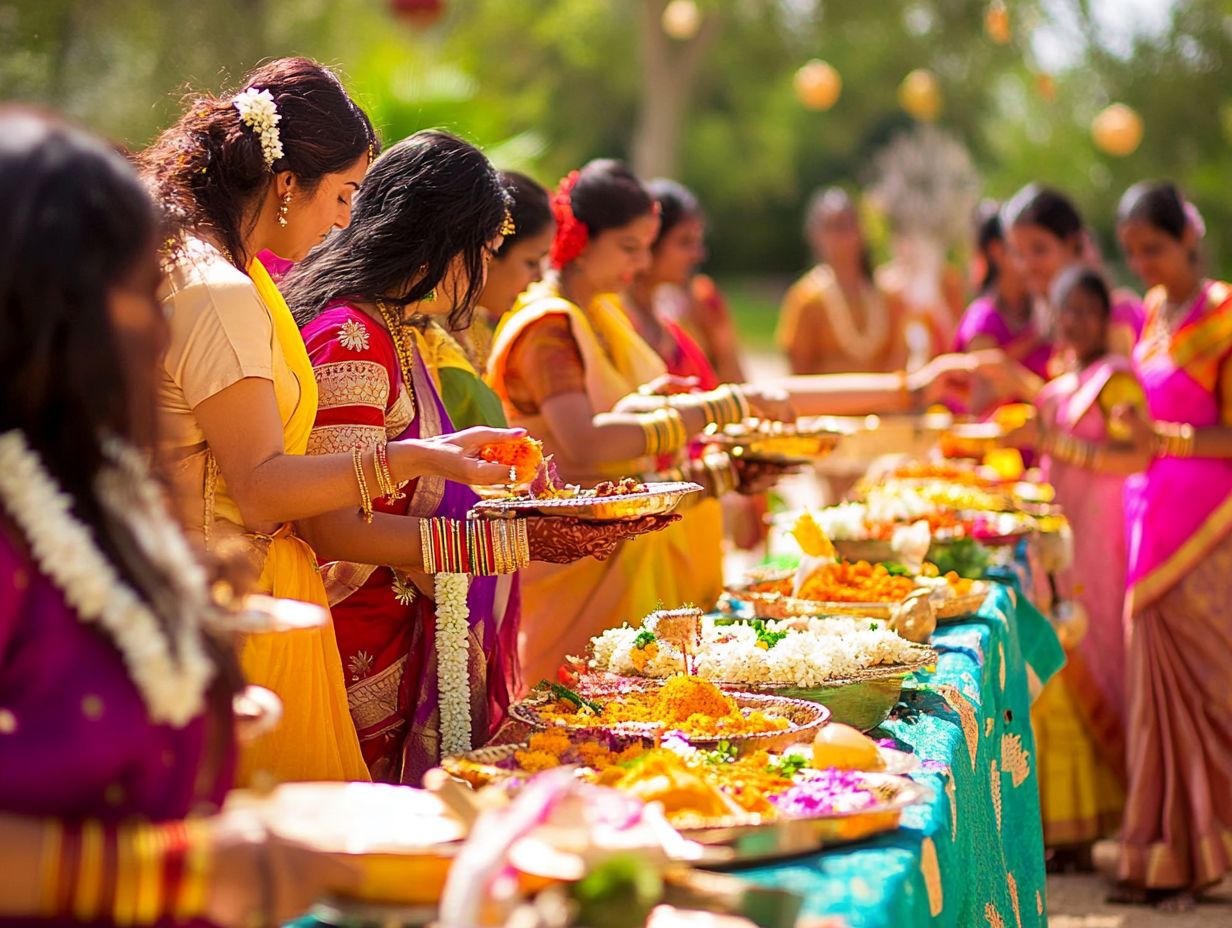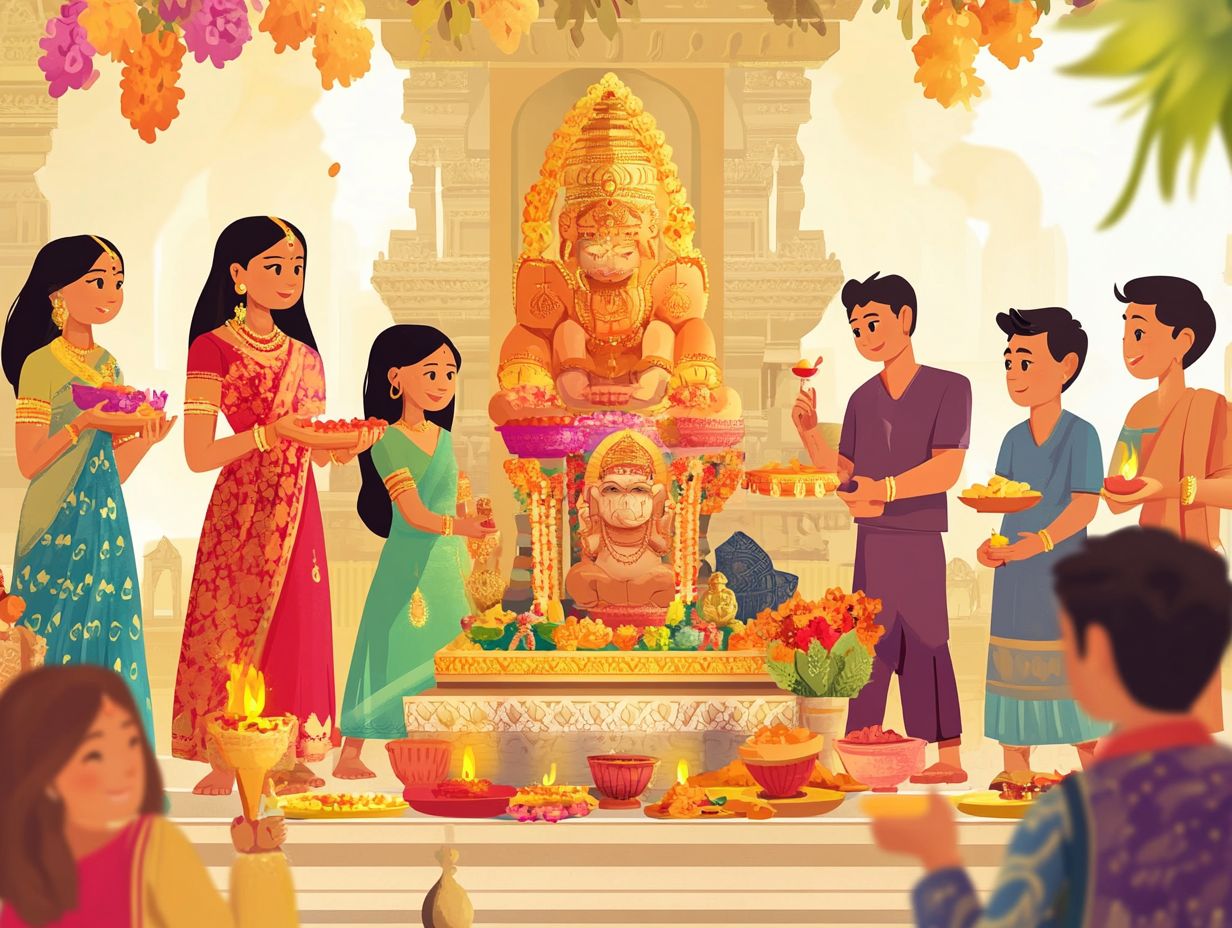How and Why Did Hinduism Spread?
Hinduism, one of the world s oldest religions, presents a rich tapestry of beliefs and practices that have evolved over millennia. This exploration delves into its origins and core beliefs, including the concepts of reincarnation, karma, dharma, and moksha, alongside the powerful deities like Vishnu, Shiva, and Shakti that shape its spiritual landscape. The influence of Hindu scriptures such as the Vedas and Upanishads is also profound, providing a foundation for its rich spiritual practices and rituals.
Moreover, it examines how Hinduism expanded beyond its homeland through political influences, migration patterns, trade routes, and cultural exchanges, ultimately establishing its presence in Southeast Asia and the broader world. This spread of Hinduism highlights its adaptability and resilience, and the fascinating journey reveals its enduring impact on global culture, inviting an appreciation for its complexity and richness.
What Is Hinduism?

Hinduism, recognized as one of the world’s oldest religions, weaves a complex tapestry of beliefs, practices, and cultural traditions that trace their origins to the Indian subcontinent over 4,000 years ago. This ancient faith encompasses a rich diversity of philosophies, rituals, and spiritual practices that shape the lives of millions, elevating it beyond mere religion to a comprehensive way of life.
Characterized by distinctive belief systems, Hinduism introduces profound concepts such as karma, dharma, and moksha, while also presenting a vast pantheon of deities, intricate rituals, and revered sacred texts, including the Vedic texts, Upanishads, Mahabharata, and Ramayana.
How Did Hinduism Originate?
The origins of Hinduism are intricately entwined with the history of the Indian subcontinent, dating back to the Vedic period around 1500 BCE, when the revered texts known as the Vedas were composed.
Over the centuries, Hinduism has undergone significant evolution, shaped by a complex interplay of cultural diffusion, migration patterns, and the integration of diverse belief systems. This process has resulted in a rich and varied tapestry of religious practices and philosophies that continue to resonate throughout India and beyond, including the ways in which relocation diffusion spread Hinduism.
What Are the Core Beliefs of Hinduism?
At the core of Hinduism lie its essential beliefs, which encompass significant concepts like reincarnation, karma, dharma, and moksha. These principles serve as guiding tenets for spiritual practices and ethical frameworks, profoundly influencing the lives of its adherents.
They underscore the crucial role of moral teachings and social responsibilities, particularly within the context of the caste system and the wider community. These social structures and family traditions are pivotal in maintaining the ethical teachings and societal influence of Hinduism.
1. Reincarnation and Karma
Reincarnation and karma are fundamental to Hindu beliefs, suggesting that the soul traverses a continuous cycle of birth, death, and rebirth, all shaped by one s actions and moral choices in previous lives. This intricate interplay between karma and reincarnation not only influences individual destinies but also highlights the ethical dimensions inherent in Hindu spirituality.
The ramifications of these concepts extend well beyond personal existence, profoundly affecting communal spiritual practices, rituals, and moral frameworks within Hindu society. Each person’s karma plays a vital role in the collective spiritual evolution of their community, underscoring a shared responsibility for ethical living and reinforcing the community’s cultural identity.
Rituals, festivals, and cultural traditions often revolve around these ideals, inspiring adherents to embody righteousness and support one another on their spiritual paths.
By weaving the principles of karma into their daily lives, practitioners not only nurture their own souls but also cultivate a sense of unity and collective advancement. This illustrates how these ancient teachings continue to resonate in contemporary discussions surrounding morality and existence.
2. Dharma and Moksha
Dharma, denoting the ethical path and duties that each individual must embrace, and moksha, representing liberation from the cycle of rebirth, stand as pivotal concepts in Hindu philosophy. These principles not only guide adherents toward spiritual fulfillment but also underscore the importance of moral living.
The understanding and fulfillment of one’s dharma are deemed essential for achieving moksha, illustrating the deep interconnectedness of ethical teachings within Hinduism.
These concepts encapsulate profound teachings that extend beyond individual behavior to shape societal norms. In the quest for self-realization, dharma acts as a compass, aiding individuals in navigating life s complexities with integrity and responsibility. It inspires adherence to cosmic law and social obligations, thereby nurturing a sense of harmony within the community.
Conversely, moksha signifies the ultimate aspiration of existence, symbolizing the soul’s liberation from the confines of the material world and its unification with the divine, often referred to as Brahman. Collectively, dharma and moksha offer a holistic framework for living, promoting personal growth while reinforcing ethical conduct as the pathway to transcendent freedom.
3. The Trimurti: Brahma, Vishnu, and Shiva
The Trimurti, encompassing Brahma the creator, Vishnu the preserver, and Shiva the destroyer, embodies the dynamic forces of creation, preservation, and dissolution within Hindu philosophy. This triad of deities represents fundamental aspects of the universe and occupies a central role in a multitude of religious practices and narratives in Hinduism.
Brahma, often illustrated with four faces that symbolize the four Vedas, is venerated as the wellspring of all knowledge and the architect of the cosmos. In contrast, Vishnu, the sustainer of life, assumes various avatars, including Rama and Krishna, to restore cosmic order and protect dharma. Shiva, renowned for his ascetic nature and profound mysticism, embodies transformation, symbolizing the cyclical essence of existence and guiding souls through the process of regeneration.
Collectively, they exemplify the intricate balance of the universe, reflecting the interconnectedness of creation, maintenance, and destruction elements that are essential for the harmonious flow of life and the cosmic rhythm.
Why Did Hinduism Spread?

The expansion of Hinduism beyond the Indian subcontinent can be attributed to a multitude of factors, notably the influence wielded by Indian kings and empires, cultural diffusion facilitated by trade routes, and the devoted efforts of missionaries and spiritual leaders.
Over the centuries, these elements have played a crucial role in weaving Hindu practices and beliefs into a rich tapestry of diverse cultures, highlighting the adaptability and resilience of this ancient religion. The role of Hinduism in fostering intercultural dialogue and interfaith relations further underscores its inclusive and pluralistic nature.
1. Influence of Indian Kings and Empires
Throughout history, the impact of Indian kings and empires has been pivotal in the dissemination of Hinduism, as rulers frequently adopted and championed the religion to unify their varied populations. This royal patronage not only catalyzed the establishment of temples and cultural institutions but also fostered a broader acceptance of Hindu beliefs and practices across diverse regions.
For example, the Gupta Empire, often hailed as the Golden Age of India, witnessed remarkable advancements in the arts, music, architecture, and literature, accompanied by a pronounced emphasis on Hindu philosophies. The kings of this illustrious era were instrumental in supporting scholars like Kalidasa, whose plays and poems resonated with Hindu ideals, thereby nurturing a cultural exchange that enriched both local and global understandings of Hinduism.
Similarly, the Chola dynasty’s influence in South India significantly contributed to the propagation of Shaivism and Vaishnavism. They constructed monumental temples and established trade routes that facilitated cultural and religious interactions with Southeast Asia. These instances exemplify how royal endorsement not only fortified Hinduism’s prominence but also intricately shaped the societal fabric and its enduring spiritual legacy. The Chola dynasty’s contributions to art and dance, particularly through temple architecture and festivals, are also noteworthy.
2. Trade and Cultural Exchange
The historical trade routes of the Indian subcontinent functioned as essential channels for the dissemination of Hinduism, fostering cultural exchanges among a multitude of communities and regions. Through the interactions with traders and travelers, Hindu beliefs and practices permeated local cultures, significantly influencing their religious identities.
Over the centuries, these intricate trade networks connected Indian merchants with distant lands, extending as far as Southeast Asia, where Hindu concepts merged seamlessly with indigenous traditions. For instance, during ancient times, the maritime Silk Route not only facilitated the exchange of goods but also served as a conduit for the introduction of Hindu epics, rituals, and iconography to regions like Bali and Indonesia. The establishment of temples and the adaptation of Hindu deities in these locales stand as testaments to this rich cultural synthesis.
Moreover, the movement of scholars and religious leaders, including missionaries and gurus, along these routes enriched the spiritual landscapes of various communities, enabling dialogue and fostering a distinctive blend of beliefs that ultimately shaped their cultural identities. This syncretism often resulted in the adaptation of Hindu rituals, festivals, and spiritual practices into local traditions.
3. Missionaries and Gurus
The contributions of missionaries and spiritual leaders, often referred to as gurus, have been pivotal in the dissemination of Hinduism across the globe. These charismatic individuals embarked on journeys to distant lands, sharing their teachings and practices with eager audiences. In doing so, they established religious communities that became essential in the adaptation and integration of Hindu beliefs, culture, and practices into various cultural contexts.
Their methodologies were remarkably diverse, employing a spectrum of approaches ranging from personal interactions and public discourse to literature, rituals, and sacred texts such as the Vedas and Upanishads that resonated with local traditions. Notable missionaries not only imparted the philosophical foundations of Hinduism but also nurtured community-based practices, facilitating authentic expressions of spirituality.
This inclusive and adaptive strategy effectively bridged cultural divides, rendering Hinduism accessible to a multitude of populations while championing its core values of peace, self-realization, and dharma. By placing a strong emphasis on personal experience and cultural relevance, these leaders have profoundly enriched the global landscape of spiritual discourse and interfaith relations.
How Did Hinduism Spread to Southeast Asia?
Hinduism permeated Southeast Asia predominantly due to the profound influence of Indian merchants and traders, who played a crucial role in fostering cultural exchange along well-established trade routes. This dynamic interaction resulted in the establishment of Hindu temples, the embrace of Hindu deities like Vishnu and Shiva, and the incorporation of Hindu art and architecture into the local cultures.
Such developments significantly transformed the spiritual landscape of the region, leaving an enduring legacy that resonates to this day.
1. Influence of Indian Merchants and Traders
Indian merchants and traders played a crucial role in the cultural diffusion of Hinduism to Southeast Asia, establishing extensive trade networks that connected the Indian subcontinent with various coastal regions. Their interactions not only facilitated commerce but also enabled the transmission of religious beliefs such as karma and reincarnation, rituals, and cultural practices.
Through these trade routes, Hindu ideas and traditions were introduced to local populations, often blending seamlessly with indigenous customs and animism. This synthesis resulted in the adoption of various Hindu symbols, deities, and narratives within local spiritual practices, enriching the cultural tapestry of regions such as Bali, Java, and parts of Cambodia.
Temples dedicated to Hindu deities emerged, serving as centers of worship and community gatherings. In many instances, local elites embraced Hindu beliefs, further solidifying the religion’s presence and influence. This ongoing exchange underscored the dynamic interplay between commerce and spirituality, illustrating how trade can serve as a powerful vehicle for cultural diffusion.
2. Influence of Indian Empires

The influence of Indian empires, particularly during the zenith of the Srivijaya and Majapahit kingdoms, played a pivotal role in the dissemination of Hinduism across Southeast Asia. These empires embraced Hinduism as a state religion, actively promoting its ideals and practices among their subjects, thereby facilitating profound cultural integration throughout the region and encouraging syncretism with local beliefs.
By weaving local customs into the fabric of Hindu beliefs, these empires cultivated a distinctive amalgamation of traditions that resonated deeply with the indigenous populations. Temples, artwork, and literature flourished, creating a rich tapestry of cultural exchange that highlighted the significance of Hindu philosophy in everyday life.
The political authority wielded by these empires further established trade routes that enabled not only the exchange of goods but also the flow of ideas and religious practices. Consequently, the impact of Hinduism on local societies was profound, transforming social hierarchies, artistic expressions, and governance structures, ultimately shaping the legacy of Southeast Asia for centuries to come.
3. Influence of Hindu-Buddhist Art and Architecture
The influence of Hindu-Buddhist art and architecture has profoundly shaped the dissemination of Hinduism throughout Southeast Asia, as splendid temples and monuments were erected, reflecting the region’s rich religious syncretism. These architectural masterpieces served not merely as sites of worship but also as potent symbols of cultural identity and spiritual heritage.
Structures such as Angkor Wat in Cambodia and the Prambanan temple complex in Indonesia stand as remarkable testaments to the intricate interweaving of Hindu and Buddhist beliefs. They feature elaborate carvings, soaring spires, and vibrant imagery that vividly narrate ancient epics. These iconic temples not only cemented the presence of Hinduism in these areas but also ignited a cultural exchange that enriched local traditions.
As pilgrims flocked to these hallowed sites, the shared artistic motifs and architectural styles cultivated a sense of unity among diverse communities, transforming these locations into beacons of religious devotion and cultural pride, and ensuring the enduring legacy of Hinduism within the intricate tapestry of Southeast Asian history.
How Did Hinduism Spread to Other Parts of the World?
The expansion of Hinduism into various regions of the world, especially the West, has been shaped by a multitude of factors, including British colonialism, the burgeoning Indian diaspora, and a growing fascination with Eastern mysticism and Hindu philosophy.
These interconnected dynamics have significantly contributed to the globalization of Hindu practices, resulting in the formation of communities and institutions that advocate for Hindu beliefs and values on an international scale. To understand this phenomenon, one can explore how Hinduism was diffused. The influence of Hindu scriptures like the Mahabharata and Ramayana has been profound in shaping the worldview of these communities.
1. Influence of British Colonialism
British colonialism exerted a complex influence on the dissemination of Hinduism, as colonial policies frequently necessitated the meticulous documentation and categorization of Hindu beliefs and practices. This process fostered a heightened awareness and interest in Hinduism, not only among colonial subjects but also within the broader Western context, facilitating a cultural exchange that redefined religious identity and encouraged intercultural dialogue.
Consequently, numerous Western scholars and travelers undertook the study and interpretation of Hindu texts, generating a fusion of perspectives and interpretations that occasionally diverged from traditional practices. Such engagement not only popularized specific elements of Hinduism but also led to the commodification of its rituals and symbols, which were sometimes misinterpreted or overly simplified for Western audiences. This period also saw the rise of Hindu reform movements that aimed to modernize and reinterpret traditional beliefs.
This era also witnessed the rise of reform movements within Hindu communities, influenced by Western ideologies, introducing new dynamics to worship and identity. Thus, the colonial period served as a catalyst for the transformation and adaptation of Hinduism, reshaping its presence on the global stage while provoking reflections on authenticity and cultural heritage.
2. Influence of Indian Diaspora
The Indian diaspora has been instrumental in the global dissemination of Hinduism, as individuals and communities migrated and established themselves in various countries. This migration has nurtured the growth of Hindu communities, enabling the preservation and adaptation of cultural practices while enhancing their cultural identity within new contexts. The diaspora has played a crucial role in organizing Hindu festivals such as Diwali, Holi, and Navratri in their new homelands.
As these communities settled in diverse regions, they began to form vibrant congregations that adhered to distinct yet interconnected beliefs and rituals. Through cultural festivals, temple construction, and educational initiatives, adherents have effectively shared their traditions, enriching the social fabric of their host nations. This movement has led to the formation of various Hindu organizations that support community outreach and the preservation of cultural heritage.
The transnational movements facilitated by technology have fostered a continuous exchange of ideas and practices, ensuring that the essence of Hinduism remains both dynamic and relevant. By engaging with local cultures while retaining their core tenets, such as dharma and karma, these global Hindu communities have significantly contributed to a broader understanding and appreciation of Hindu philosophy, thereby promoting a greater sense of multiculturalism.
3. Interest in Eastern Mysticism and Philosophy
The growing interest in Eastern mysticism and philosophy throughout the 20th century has significantly facilitated the spread of Hinduism in the West. This burgeoning fascination has led to the adoption of Hindu practices such as yoga and meditation, which serve to promote the religion’s spiritual teachings and ethical values across various cultural landscapes. This interest has also ignited discussions about sustainability and environmentalism within the context of Hindu teachings.
During this transformative period, influential figures like Swami Vivekananda and Paramahansa Yogananda played crucial roles in introducing Eastern thought to Western audiences, thereby fostering a deeper appreciation for the spiritual philosophies that underpin these practices. The counterculture movement of the 1960s and 1970s further embraced elements of Hinduism, particularly transcendental meditation, as pathways to personal liberation and holistic well-being. This era also saw the rise of interfaith relations and intercultural dialogue, enriching the spiritual landscape.
As a result, this rapid exchange of ideas has given rise to a form of spiritual globalization, where Western seekers of truth engage with ancient wisdom to enhance their own lives. This dynamic interaction has resulted in a distinctive fusion of traditions, rituals, and philosophies that continues to evolve and enrich contemporary spiritual practice, highlighting the impact of Hinduism and its spiritual practices such as yoga and meditation.
Frequently Asked Questions

What is Hinduism and how did it spread?
Hinduism is a religious and cultural belief system originating in ancient India. It is one of the oldest and most diverse religions in the world, deeply embedded in the history and culture of the region. Hinduism spread through a combination of cultural diffusion, migration, trade routes, and conquests by ancient Indian rulers.
Why did Hinduism spread to other parts of the world?
Hinduism spread to other parts of the world because of its flexible nature and ability to adapt to different cultures. Its religious tolerance and the appeal of its diverse philosophies, scriptures like the Vedas and Upanishads, and epics like the Mahabharata and Ramayana also contributed to its spread. Additionally, Hinduism gained popularity through trade routes and the migration of Hindu merchants to other countries.
How did Hinduism spread to Southeast Asia?
Hinduism spread to Southeast Asia through the Indianization of the region. Indian traders, priests, and merchants brought Hinduism with them as they established trade routes and settled in the region. This cultural exchange led to the syncretism of local beliefs with Hindu traditions, influencing the region’s culture, art, and architecture.
Why did Hinduism spread to Nepal and Tibet?
Hinduism spread to Nepal and Tibet due to cultural diffusion and the influence of Hindu and Buddhist missionaries who traveled to these regions. The spread of Hinduism in these areas also led to the development of unique branches of Hinduism, highlighting the importance of pilgrimage, sacred geography, and the integration of local animism and indigenous beliefs.
How did Hinduism spread to the West?
Hinduism spread to the West through the migration of Indian immigrants and the popularity of Eastern spirituality and mysticism. In the 19th and 20th centuries, Hindu gurus and teachers also traveled to the West, introducing Hinduism to a wider audience. This intercultural dialogue and interfaith relations further promoted the adoption of Hindu spiritual practices, such as yoga and meditation, in the West.
Why did Hinduism spread to different castes and social classes?
Hinduism spread to different castes and social classes due to its inclusive nature and the belief in reincarnation and karma. Hinduism does not discriminate based on social status, and people from all backgrounds are able to practice and follow its teachings. The caste system, though complex, allowed for a variety of social structures and community bonds, promoting the widespread practice of Hinduism.
